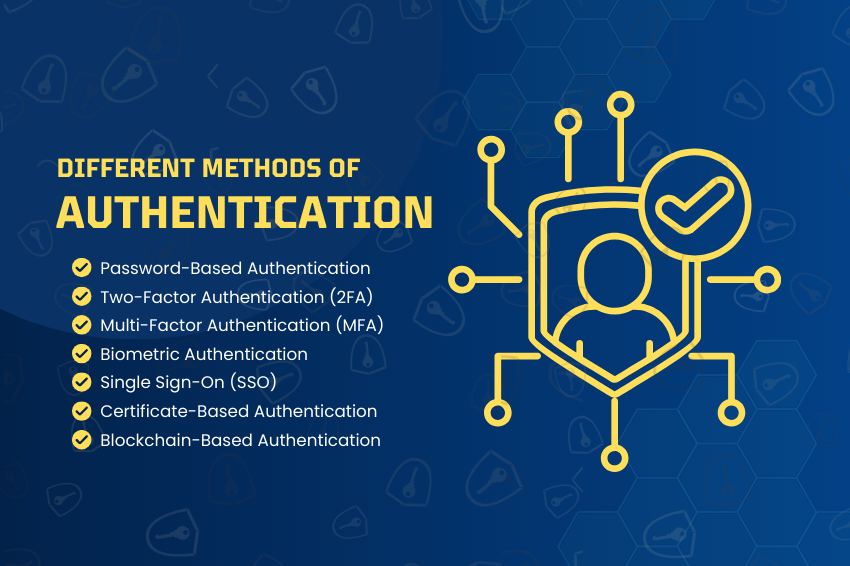In today’s business world, organizations are heavily dependent on systems, data, and applications, so implementing different authentication methods is a crucial factor, and appropriate measures must be taken to guarantee their security. Most organizations are vulnerable to cyber threats and many are heavily dependent on Internet-based resources, so efficient authentication mechanisms are needed.

This article aims to highlight the importance of authentication as it is the identification of a user, system or extensively used in cyberspace. Let’s understand different authentication methods, strengths, weaknesses as well as guidelines to adoption of the same for the purpose of security in the digital realm.
Introduction to Authentication
The mechanism of authentication plays the primary role as the base of access control in cybersecurity. It makes sure that only permitted individuals have a chance to come across secure data and applications.
Basically, the process of authentication is intended to provide confirmation in the identity of the user, device, or system before it is admitted to the network.
Lack of proper authentication means that persons who are not authorized to gain access can access the network and probably manipulate loopholes to steal or delete information from the organization’s network or even bring in viruses, thus causing the organization to suffer a loss, or tarnish its image.
Types of Authentications
There are generally three basic types of authentications:
- Knowledge-Based Authentication (KBA): This involves something only the user knows such as PIN, passwords as well as answers to security questions. Despite its use in many organizations, KBA is at risk of phishing, social engineering, and brute force attack.
- Possession Factor Authentication: This factor involves something the user has for instance, a token, smart card, mobile phone etc. As a result, possession-based authentication is effective since the physical device is essential in the authentication process.
- Inherence Based Authentication (Biometrics): The user is identified based on his natural traits like fingerprint, face, etc. Biometric identification is a reliable method as it is difficult to imitate the traits of a person.
Traditional Authentication Methods
Password-Based Authentication (PBA)
Passwords can be described as the primary method for staff to identify themselves to computer systems. It is used to create a log-in name or password which is an efficiently hidden phrase or sequence of characters in a particular machine. Admittedly, despite the fact that passwords are rather simple, they can be penetrated through a number of attacks, such as:
- Phishing: It is a form of attack where attackers try to lure the user into providing password information in the form of link, email or website.
- Brute Force: This is a process that utilizes automated tools to input passwords in an aim of guessing.
- Credential Stuffing: It is a technique of authenticating attacker by using stolen credentials from one breach to repeat the same process in other accounts.
To minimize these risks, strong password policies should be adopted in the organization to include the complexity, frequency, and the use of passwords managers.
Also Read – Staying Ahead of Phishing Attacks
Two-Factor Authentication (2FA)
Two factor ID adds another chord of protection for the user, meaning one is required to present two forms of identification. In general, 2FA uses a secret or a knowledge factor, such as password, in addition to a possession factor, such as mobile device or hardware token, or an inherent factor, viz. biometric data. High security is achieved by this method since even if the password to the home page is intercepted, it cannot grant access to any other page in the system.
Multi-Factor Authentication (MFA)
MFA is the enhancement of the basic 2FA since it uses several factors for authentication. Some of the interventions that are found within MFA are as follows:
- Knowledge (passwords, security questions)
- Possession (security tokens, mobile devices)
- Inherence (biometric verification)
Therefore, MFA is regarded as one of the most effective technologies for providing digital access since it increases the level of protection as much as possible for an attacker to crack the code.
Advanced Authentication Methods
Biometric Authentication
Biometric authentication is an approach in which personal identity is confirmed based on physiological properties of human body. Common biometric methods include:
- Fingerprint Identification: This is the process where the users are identified through their fingerprints. Broadly utilized in iPhone and security systems.
- Facial Recognition: Checking the faces and particular features of the official or the suspect for identification. Applied into the security cameras and mobile devices.
- Iris and Retina Scanning: Examining the unique patterns of the iris or retina. Common in high-security environments.
- Voice Recognition: Employing users’ voice to identify them. It is deployed in virtual assistant applications and for secure access controls.
This security technology eliminates the use of personal passwords and brings the ease and security measures into consideration but also brings about privacy issues. There are therefore important ways that organizations should ensure that biometric data is properly guarded and used appropriately in the course of the activities of the organization or company involved.
Single Sign-On (SSO)
SSO means that a user logs in just once and gets access to all the apps and/or systems that the user needs to use. SSO improves the user experience by eliminating multiple passwords, while also providing a secure single authentication point.
Certificate-Based Authentication
The main essence of the certificate-based authentication mode is the usage of digital certificates for an identity check. Certificates must be purchased from accredited Certificate Authorities and contain public key and the client identification data. This method is widely applied for protecting web communication channels (SSL/TLS) as well as for authenticating devices in corporate networks.
Blockchain-Based Authentication
Blockchain technology proposes the use of the distributed database to implement authentication. This way, it is possible when applying the basic principles of blockchain, due to which the changes made to the ledger are recorded permanently and cannot be modified to create effective and highly-secure authorization systems within the organization. Probably fresh, but without fail a new technology, blockchain authentication is very promising for increasing transparency and security.
Challenges in Authentication
Despite the improvements in the process of authentication, it is not without the following:
- User Experience: User has to go through long processes of authentication to get into the facilities thereby diminishing user experience and compliance.
- Security vs. Convenience: This is one of the critical concerns that need to be addressed, as they have reported difficulties in finding ways to enhance the security feature as well as adopt the convenience factor.
- Cost: Due to the nature and complexity of the solutions, often, the cost of deploying sophisticated methods of authentication might drain the finances of even SMEs.
- Privacy Issues: Enhancing the level of security by using biometrics as well as other advanced approaches can present privacy concerns, and therefore, information ought to be well handled keenly.
Best Practices for Securing Digital Access
For organizations therefore to ensure comprehensive security of digital access, several of the following practices are recommended:
- Strong Authentication Policies: Require password strength that has to be a combination of letters, numbers and symbols and ensure that there is formulating change of the policies regularly to embrace all threats involved.
- Require MFA & 2FA: For protection of the organization’s critical IT assets, it is crucial to set and enforce the use of multi-factor or two-factor authentication.
- Secure Biometric Authentication: For an enhanced security use of the biometric feature where necessary but ensure that the biometrics data is protected well and those who are inputting the information do so in a legal way.
- Educate Users: Popularize the high-level security that is provided due to the strong authentication and educate users about the dangerous of phishing and other online fraudulent techniques.
- Audit the Authorization: There should be a regular check of the records of the users who had access to the system and the activities that they engaged in while performing the authorization tasks.
- SSO Solutions: Employ Single Sign-On solutions to manage the access issues with ease while ensuring security.
- Biometric and Personal Data: The biometric and personal information collected should be well protected against privacy and data breaches.
- Update with Emerging Technologies: Learn or become acquainted with new technologies in authentications and incorporate them into the security structures if necessary.
Conclusion
Cyber threats are rapidly increasing in the digital environment, exclusive access to them is important for securing connections. The authentication mechanism serves a great purpose of protecting resources such as systems, data, and applications from unauthorized access. Despite these traditional authentication methods, modem approaches are much more effective and can include physical measurements, MFA, and blockchain solutions.
Organizations also need to implement multiple factors for the authentication process, the issue here is to maintain security while considering the ease of use, privacy concern, and the cost of implementing the multiple layers of security. Thereby, high level of IT security contributes to minimization of the threats of cyberattacks and maintenance of confidentiality and integrity of organizational data.
As technology continues to evolve, you need to stay well informed about these authentication methods and ensure that online access is as secure as possible.


